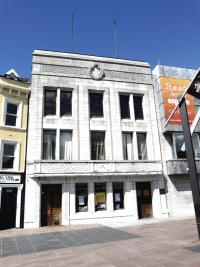Cork City Library
Published in 18th–19th - Century History, 20th-century / Contemporary History, Features, Issue 1(Jan/Feb 2012), Volume 20
Cork City Library—consciously Hibernian in style—with beautiful Celtic-style carving around the entrance doors and on the balustrade along the first floor. (NIAH)
Cork was the first of Ireland’s cities to adopt the Public Libraries Act in the mid-nineteenth century. The city’s main library was housed in a variety of locations between 1892 and 1930, but when Corkonians think of the ‘City Library’ they think of the landmark building on the Grand Parade, opened in September 1930. The construction owes much to the resilience of then city librarian James Wilkinson in the face of great adversity, in particular the destruction in 1920 of the Carnegie Free Library on Anglesea Street during the War of Independence. Wilkinson, a Yorkshireman, was Cork librarian for 40 years until his retirement in 1933.The City Library was designed in a consciously Hibernian style, like some other buildings in the city built after the burning of Cork, for example the former Egan’s shop (1924) in St Patrick Street. The design was by the city engineer of the time, Joseph Delaney (d. 1942). It features a façade of Cork limestone, three-bay on first and second floors, with beautiful Celtic-style carving around the entrance doors, on the balustrade along the first floor and on the coping at the top of the building. The carving on the balustrade has the arms of Cork (two towers and a ship in full sail, with the motto Statio bene fide carinis) displayed in the centre, while the coping prominently features the harp, symbol of the new state. The façade is included in the National Inventory of Irish Architecture, although the original structure behind the façade is long gone.The 1930 building had a narrow frontage on the street at nos 57 and 58 Grand Parade, but the interior of the library was quite large, occupying ground that had previously housed warehouses between Kift’s Lane and Tuckey Street. From the hallway one entered a circular lobby that led on to the main corridor, off which were the newsroom, reference library, adult lending library and juvenile library. The newsroom was a well-known feature of the library, as crowds of users, often older men, read pages of the Echo, Examiner and other newspapers set out on high, sloping lecterns. On wet days (not unknown in Cork!) the newsroom had a distinctive aroma, as the public checked up on the latest world news, and the runners and riders at Haydock. The upper floors at the front provided living accommodation for the city librarian and his family until the early 1970s. For decades the library provided a service that is still warmly remembered, as evidenced by the accounts of borrowers from that era. In a time of few other recreational opportunities, the level of borrowing was high; it was not unknown, especially on a Saturday, to see queues of children out the door and around the corner into Grand Parade. The City Library was redeveloped in the second half of the 1970s to a design by Kelly, Barry & Associates, with much greater street frontage on the Grand Parade, so that it now occupies nos 57–61, and with greatly enhanced facilities. The reference library is now on the first floor at the front, with the local studies library on the floor above. The children’s library occupies the space directly behind the 1930 façade, and the adult lending library takes up most of the rest of the ground floor. A great innovation from the time of the extension of the City Library is the music library (since 2004 called the Rory Gallagher Music Library), a hive of music and knowledge at the rear of the building. HI
Liam Ronayne is Cork City Librarian. Series based on the National Inventory of Architectural Heritage’s ‘building of the month’, www.buildingsofireland.ie.
















